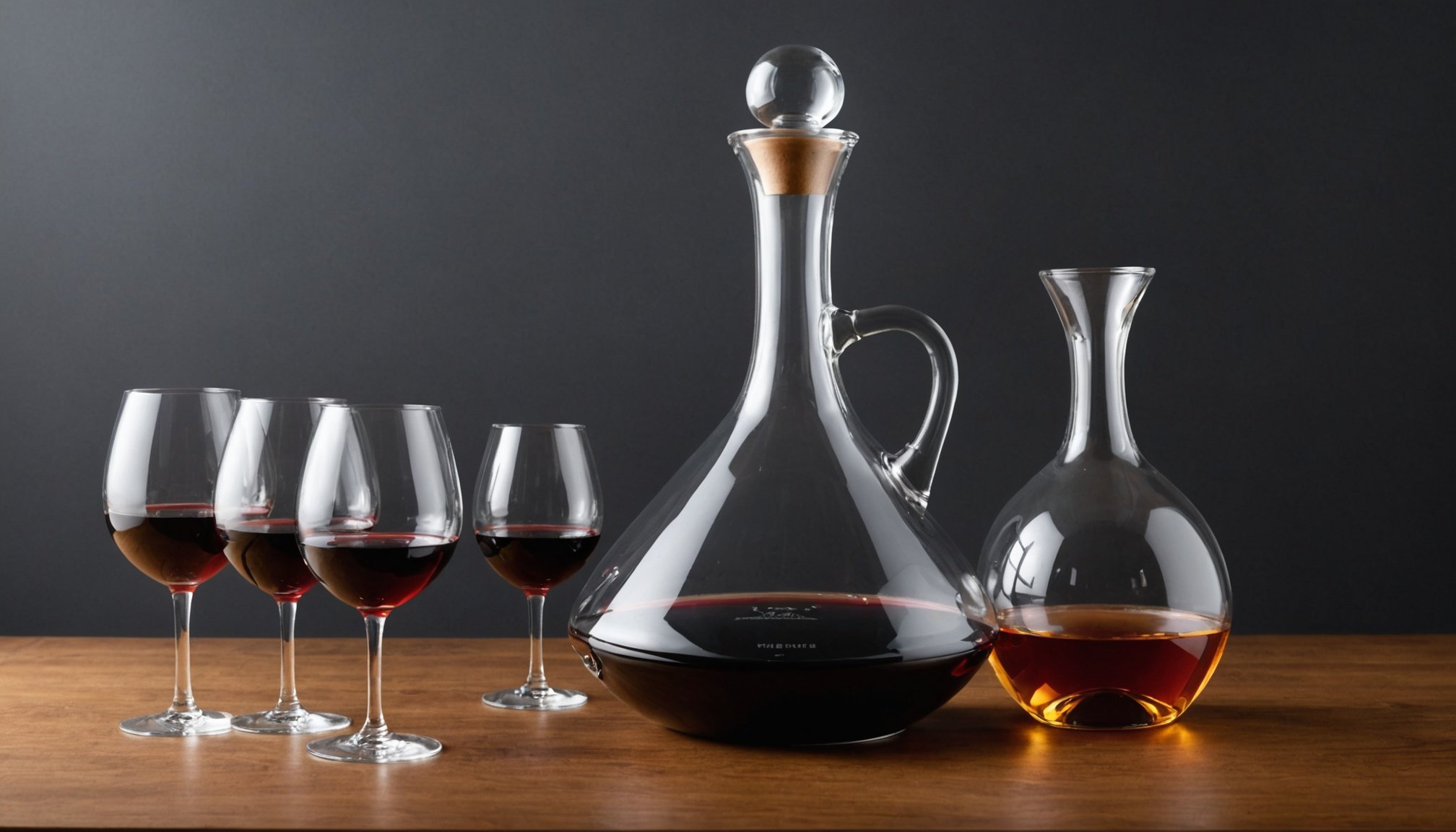Overview of Wine Decanters
Understanding the various wine decanter types and their roles is crucial for any wine enthusiast. Decanters not only serve as vessels for pouring and serving but also significantly impact the flavour and aroma of wine. Generally, decanters can be categorized into traditional, aerating, and modern designs—each with unique purposes.
Benefits of decanting include enhancing the wine’s flavour by aerating it, which allows the wine to breathe, releasing complex aromas and softening tannins. This process is essential for younger wines that may taste harsh straight from the bottle. Decanters also separate sediment in older wines, ensuring a smoother, more enjoyable experience.
Have you seen this : Ultimate guide to choosing the ideal kitchen faucet for your modern uk home
Moreover, the appreciation of wine is considerably elevated through decanting. Allowing wine to reach its full potential changes the drinking experience, making it more pleasurable and enriching. The ritual of using a decanter adds a touch of sophistication, helping to slow down the pace, allowing individuals or gatherings to savour each moment.
Embracing the use of a wine decanter can transform a regular dinner into a more refined occasion, bringing out the best in the wine and the people enjoying it.
Also to discover : Ultimate guide to installing an exceptional kitchen ventilation system for your uk home
Key Features to Consider in a Wine Decanter
When exploring wine decanter features, design considerations play a pivotal role. A decanter’s shape can greatly affect pourability and the wine’s exposure to air. Some designs, like the classic wide-bottomed shape, improve aeration effectively. Pourability is another crucial factor—look for a decanter that allows smooth, drip-free pouring to avoid spills and maintain elegance.
Aesthetically, a decanter can serve as a centrepiece on a dining table, so consider designs that complement your style.
Material Comparisons
Material is a significant consideration as it can influence both the functionality and durability of a decanter. Crystal decanters are cherished for their clarity and brilliance, often preferred for special occasions. However, they can be quite fragile and require careful handling. On the other hand, glass decanters offer sturdiness and are easier to maintain, making them practical for everyday use. Although less common, some decanters come in plastic, offering durability but lacking in elegance and sophistication.
Size Considerations
Size choice is also key, as it should match the type and quantity of wine you typically serve. Smaller decanters suit single-bottle servings, whereas larger ones can accommodate multiple bottles, ideal for gatherings. An appropriately sized decanter ensures optimal wine enhancement and an enjoyable experience.
Comparing Different Types of Wine Decanters
Selecting the right types of wine decanters is crucial for enhancing the wine’s complexity and presentation. They come in various designs—each tailored for specific needs. Understanding these designs can enhance both novice and expert wine experiences.
Traditional Wine Decanters
Traditional decanters are often elegant and timeless. They typically feature a wide base, promoting wine aeration and aiding in sediment separation from older wines. While their classic appeal and functionality are valuable, handling them requires care due to their fragility.
Aerating Wine Decanters
Aerating wine decanters have gained notoriety for their innovative capabilities, rapidly introducing oxygen to wine. With built-in mechanisms, these decanters significantly reduce waiting time, making them ideal for wines that require quick aeration. However, some purists argue they may not allow the wine to open up as naturally as traditional designs do.
Modern and Innovative Designs
The world of modern decanters brings forth sleek, contemporary designs tailored for both function and aesthetics. These innovative designs often incorporate unique shapes and advanced materials, enhancing usability and visual appeal. While modern decanters often offer versatility, they may lack the tradition-rich charm of conventional decanter designs. Balancing practical features and style ensures the perfect decanter choice for an enriched wine-tasting experience.
Practical Tips for Using a Wine Decanter
Decanting wine can be an artful process, enhancing your overall wine appreciation. Knowing the proper decanting techniques is crucial for different wine types. Generally, red wines benefit most. For young, tannic reds, allow at least one hour to breathe. Delicate aged wines require minimal decanting to avoid losing their subtle notes. Precise timing ensures each wine expresses its best characteristics.
Temperature plays a vital role in serving wine post-decanting. Reds typically thrive around room temperature, while whites are best served slightly chilled. Proper temperature accentuates the wine’s inherent flavors, making each sip delightful.
Common mistakes include over-aerating or decanting unsuitable wines. Not all wines benefit from extensive aeration; whites and some light reds need less time. Avoid vigorous pouring to prevent disturbing sediment in aged wines.
When using a wine decanter, focus on the ambience created during serving. The ritual becomes a part of the wine appreciation, turning a simple task into a refined experience. Use these techniques as a guide to maximize flavor and create a memorable serving experience tailored to each unique wine.
Maintenance and Care for Wine Decanters
Proper cleaning of wine decanters is essential to maintain their beauty and functionality. For glass decanters, use a mixture of warm water and mild detergent, paired with a soft brush or decanter cleaning beads to avoid scratches. Avoid harsh chemicals as they can degrade the material over time.
Crystal decanters require extra care. So, use lukewarm water and non-abrasive cleaning agents to preserve their elegance. Drying thoroughly after washing is important to prevent water stains and odours.
Storage is also vital in maintaining a decanter’s integrity. Ensure decanters are stored in a cool, dry place, away from direct sunlight, which could cause glass or crystal to weaken or discolour. Use a dedicated storage rack or padded cupboard space to protect from accidental bumps or falls.
Preventing scratches and cloudiness enhances the decanter’s longevity. Regular checks for unnoticed sediment build-up, which can cause cloudiness, are advised. For fragile crystal, consider storing it separately from heavier glassware to reduce the risk of scratches.
Incorporating these care instructions will ensure your decanter offers years of enhanced wine enjoyment, combining both elegance and practicality at each dining occasion.
Budget Considerations and Recommendations
Exploring wine decanter affordability is crucial for both novice enthusiasts and seasoned collectors. Understanding budget ranges helps individuals find the ideal decanter that suits their needs without breaking the bank. In the UK, decanter prices vary widely, influenced by factors such as material, design, and brand prestige.
When seeking brand recommendations, consider esteemed names known for exceptional quality and design. Brands like Riedel and Waterford are renowned for their exquisite crystal decanters, offering luxury options that cater to upscale experiences. For more budget-friendly alternatives, look to brands like Libbey or Luigi Bormioli, which deliver style and functionality at a lower cost.
For those ready to purchase, consider supporting local UK retailers. Stores such as John Lewis and House of Fraser stock diverse collections, while smaller boutique shops provide unique selections. Online options are plentiful, with companies like Amazon and Wayfair offering convenient access to a range of prices and styles.
Align the choice of decanter with personal preferences and budget, ensuring both practical use and aesthetic delight. Balancing quality and cost empowers enthusiasts to invest in a decanter that enhances their wine experiences while fitting seamlessly into their lifestyle.
Integrating a Wine Decanter into Kitchen Décor
Integrating a wine decanter seamlessly into your kitchen décor can elevate both the functionality and aesthetic appeal of the space. Displaying decanters can turn them into striking art pieces, enriching your kitchen’s ambiance. Selecting the right design is key; consider your kitchen’s overall style, whether it’s modern, traditional, or eclectic.
When choosing a decanter for its decorative element, balance functionality with design to ensure it enhances your wine experience. Opt for decanters with elegant shapes or unique craftsmanship that complements your style. A classic crystal decanter can evoke a timeless elegance, while a modern decanter might feature sleek lines suitable for contemporary décor.
For displaying decanters, consider using open shelves, a dedicated bar cart, or even a central island. This not only allows for easy access but also showcases your wine tools prominently. Position decanters alongside complementary items like wine glasses to create a cohesive look.
Additionally, use lighting to highlight your collection—a spotlight or under-cabinet LED lighting can add a touch of sophistication, highlighting the decanter’s brilliance. Ultimately, your kitchen décor should reflect personal taste, making each decanter both a practical tool and a stylish ornament. This enhances both your wine and home experience.











